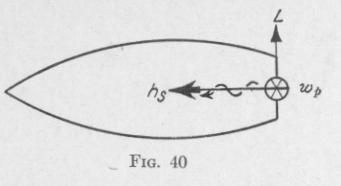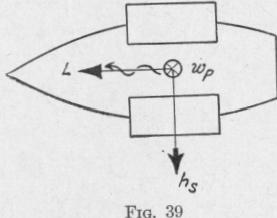50 MOTION OF A SPINNING BODY
(a) a downward force on the hub will steer the wheel to the left; (b) if the wheel is making a turn to the right and tilting over toward the right, a push forward
on the hub will bring the wheel more nearly upright.
2. The face of a certain wheel is not perpendicular to the shaft to which it
is keyed. Show that when the shaft rotates it tends to precess and the bearings are acted upon by a torque about an axis which is not constant in direction.
32. Change in the Motion of a Ship Produced by Precession of
the Shaft. - Suppose that a wave exerts a torque on a side-wheel
steamer causing the steamer to roll to the starboard.* In Fig.
39, the direction of the angular momentum of the paddle-wheels
and connecting shaft is indicated by h,, and the direction of the
applied torque by L. The direction of the precessional velocity
thereby produced is indicated by wp. The precession causes the
bow to turn to the starboard. The development of the precession
WP causes a torque about the same axis as the precession and in the same sense. Since the spin-axis tends to set itself parallel to this torque-axis, and with the direction of spin in the direction of the torque, it follows that the roll to starboard is opposed. A starboard roll causes the starboard paddle-wheel to dip deeper into
the water than the port paddle-wheel. This produces a turn
ing of the bow toward the port, thereby opposing the starboard
turning due to precession.
A side-wheel steamer turning to the starboard under the action of the rudder will heel to the port on account of precession.
In the case of a ship with screw propeller, the effects of rolling and pitching are not the same as in the case of a side-wheel steamer. So long as the shaft is horizontal, a side-wheel steamer is not precessed by pitching and a screw propeller steamer is not precessed by rolling. Suppose that the angular momentum h3 of the shaft and propeller of a ship is in the direction indicated in Fig. 40. If a wave exerts a torque in the direction represented by L tending to raise the bow or lower the stern, the bow of the ship will turn to starboard about a vertical axis with angular velocity
* The starboard side of a ship is the right-hand side and the port side is the left-hand side when the observer has his back to the stern and his face toward the bow.
MOTION OF A SPINNING BODY 51
wp. This precessional velocity implies a torque about the same
axis and in the same sense. Since the spin-axis tends to set itself
parallel to this torque-axis, and with the direction of spin in
the direction of the torque, it follows that the precession de
creases the angle of the pitch
that produced it.
A side-wheel steamer will
roll less and pitch more than
a screw propeller steamer if
corresponding dimensions are
equal.
Show that when a screw
propeller steamer is at the same time rolling and pitching, the
bow is deflected back and forth out of the proper course of the
ship. This effect is called " yawing " or " nosing."*
33. Deviations of the Course of an Airplane Produced by Pre
cession of the Propeller Shaft. - Consider an airplane of which
the single propeller, shaft, and rotating parts of the engine have
considerable angular momentum hs with respect to the spin-axis, Fig. 41. If no torque be applied tending to change the direction of the spin-axis, the axle will maintain its direction in space, Art.
16. If a torque be applied in the direction represented by L,
by rudders or any other means, tending to tilt the head upward,
then the spin-axis with the attached airplane will precess with
an angular velocity represented by wp. With the
directions of spin and of
torque as indicated in the
figure, this precession will
turn the head to the right.
If the precession be retarded by steering to the
left, that is by applying a
torque opposite the direction of wp, then the spin
axis will tend to set itself
parallel to the new torque-axis and the head will rise still more. If, however, the precession be accelerated by steering to the right, that is by applying a torque in the direction of wp, then the head will be tilted downward. Thus it is seen that in order to turn an
* Suyehiro, " Yawing of Ships," Trans. Int. Nav. Art., 1920, pp. 93-101.


